

Featured Article of the Month
My journey with taiko in Singapore
By Ms Namiko Sakai
| DON DON DON! That is how we describe the sound of the taiko (Japanese Drums). I have been in Singapore for 19 years and this sound is always with me. I feel so happy to know many people enjoy this sound, and that we can contribute to Singapore’s community by doing what we love. We are fortunate to have met many wonderful people who love taiko, as well as other aspects of Japanese culture. | 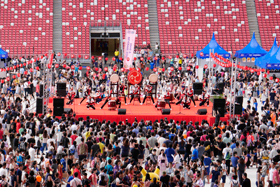 Summer Festival 2018, Photo by JAS. |
| I believe that many people in Singapore have heard the beat of the taiko on various occasions such as the JAS Summer Festival and Chingay Parade. Taiko is something anybody can enjoy without any deep knowledge and easily relate to Japan. We have had great opportunities to perform in many events organised by various organisations such as The Embassy of Japan, Japanese Association and local government agencies. In 2016, there were many special events to celebrate the SJ50 (50th Anniversary of Singapore-Japan Diplomatic Relations). We also invited KODO, one of the renowned taiko groups from Japan. What was most memorable is that there are many groups and people who actively enjoy Japanese culture. | 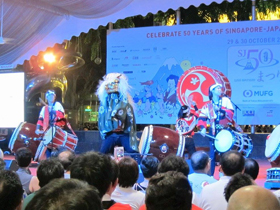 SJ50 Matsuri 2016. |
| One of our special sensei (masters) from Japan says, “It is not good enough if we just introduce or perform our culture if we want to promote it. We should aim high, so that local people become interested and want to try by themselves instead of just watching.” His words had a very strong impact on me and I always remember this. Since then, teaching taiko is an important role for me on top of performing. I hope to continue to be a bridge between Japan and Singapore. I am also very fortunate to have had the opportunity to work closely with JCC from Day 1 at the Opening Ceremony. It was my greatest honor and pleasure to have played taiko in front of both the Prime Ministers of Singapore and Japan on 14 November 2009. | 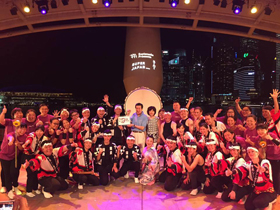 Super Japan 2016 at Esplanade, Outdoor Theatre. |
| Being in a multiracial country, we have an abundance of opportunities to meet up and collaborate with other similar music - Chinese drums, Malay drums, Indian drums and more. When I joined the Chingay Parade, it was still held at Orchard Road. We enjoyed jamming with other contingents before the actual parade started. A magic of percussion instruments, where we can communicate through the beat regardless of the language we speak. | 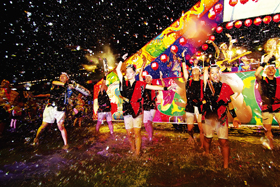 Chingay Parade 2012, Photo by JAS. |
| We also have many chances to introduce our culture to children in Singapore. Our programme comes under the NATIONAL ARTS COUNCIL-ARTS EDUCATION PROGRAMME. Many students have enjoyed TAIKO with us and have learned some Japanese words and cultural aspects, such as the Japanese way of greeting. When I teach taiko, I teach the same way I was taught, which is called 口唱歌 KUCHISHOGA (mouth singing - mouthing the sounds) and it goes “DON DON DON!”. We can even describe the dynamics and expression with it. Even though many contemporary taiko groups use music scores these days, I still prefer this style of singing when I learn new songs. | 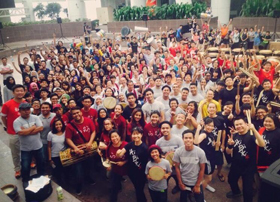 Marina Countdown 2015 “Drum Gaia” with 400 ethnic drummers. |
| Our voice also plays an important role too. Unlike the western orchestra, we don’t have a conductor. We connect to each other through breathing together in order to play together. One of the kakegoe (shouting) I use often when I teach taiko is “SO-RE!”. This is a signal from me that I am going to beat. After playing together for about an hour, all those around me naturally respond to my “SO-RE” and start shouting the same in unison. I strongly believe that the taiko is a good form of teambuilding and a great platform for improving communication skills. And we have more and more groups to try taiko for various objectives such as teambuilding, cultural experience and recreation. We recently assisted some childcare centres for their graduation ceremony. | 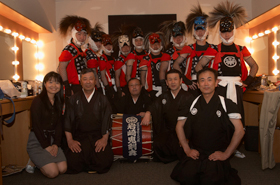 Iwasaki Onikenbai at Esplanade Outdoor Theatre 2012. |
| HIBIKIYA is celebrating its 10th Anniversary this year, and continues to promote and introduce Japanese culture in Singapore. I am looking forward to meeting more people, more exploration and exchanges. I would also like to introduce more unique culture to Singapore! |
About the Author
|
Ms Namiko Sakai is the founder and managing director of HIBIKIYA. She has been actively promoting Japanese culture including TAIKO - Japanese drums and other instruments. On top of performing and teaching, she visits various festivals in Japan and brings unique local cultures to Singapore including ONIKENBAI (Iwate prefecture) and IWAMI KAGURA (Shimane prefecture). HIBIKIYA will be celebrating its 10th anniversary this year and will have an anniversary concert on 18 May 2019 at the Esplanade, Recital Studio. * All photos used in this article are provided by the author / © Ms Namiko Sakai unless otherwise stated |
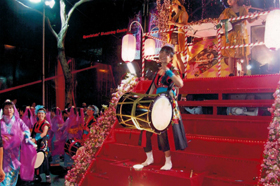 Ms Namiko Sakai at Chingay Parade. |
|
Japan Creative Centre 4 Nassim Road, Singapore 258372 +65 6737 0434 / jcc@sn.mofa.go.jp http://www.sg.emb-japan.go.jp/JCC Nearest parking at Orchard Hotel & Delphi Orchard |
 |